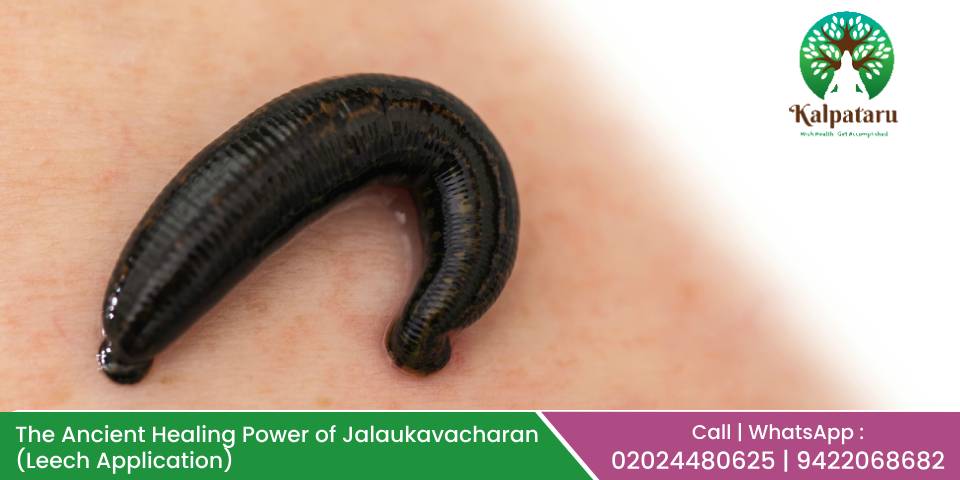In Ayurveda, the importance of body detoxification for maintaining health is well established. Panchakarma, the fivefold purification therapy, is a vital component of Ayurvedic treatment that includes Vaman (emesis), Virechan (purgation), Basti (enema), Nasya (nasal cleansing), and Raktamokshan (bloodletting). Among these, Raktamokshan, particularly through Jalaukavacharan (leech therapy), holds a unique place due to its ability to purify the blood.
The Significance of Raktadhatu in Ayurveda:
In Ayurveda, the human body is composed of seven fundamental tissues, or dhatus: Rasa (plasma), Rakta (blood), Mamsa (muscle), Meda (fat), Asthi (bone), Majja (bone marrow), and Shukra (reproductive fluids). Rakta, being a fluid tissue, carries nutrients and waste products, making its purity essential for overall health. If toxins or impurities accumulate in the blood, they can lead to various health issues. This is where Jalaukavacharan comes into play, purifying the blood and restoring balance to the body.
Jalaukavacharan: An Ancient Practice:
Leech therapy has been used since ancient times, with evidence of its practice in many parts of the world. In Ayurveda, Lord Dhanvantari, the God of medicine, is often depicted holding a leech in one hand, highlighting its significance. The medicinal leech, scientifically known as Hirudo medicinalis, plays a key role in this therapy.
For more information and treatment modalities watch our informative video
How Does Jalaukavacharan Work?
Leeches are known for their ability to improve blood circulation and help in reducing infections, thanks to the anticoagulant, anti-inflammatory, and antimicrobial properties found in their saliva. Leech saliva contains various bioactive substances that aid in relieving pain, reducing swelling, and accelerating healing.
Before application, carefully selected, healthy leeches are chosen based on their activeness and non-toxic nature. The treatment area is cleaned thoroughly, and the leech is gently placed on the skin. It then attaches itself and begins to suck blood. To maintain a moist environment conducive to the leech’s natural function, a damp cloth or cotton is placed over it. The procedure typically lasts between 45 minutes to 1 hour, during which about 5-10 ml of blood is extracted. The leech effectively removes toxins, infectious agents, and inflammatory components from the affected area, providing almost immediate relief to the patient.
Especially in patients with herpes infections, who often haven’t slept for days due to severe pain and discomfort, this treatment provides significant relief. After undergoing the therapy, their pain, swelling, itching, and redness reduce considerably. In many cases, patients are able to sleep right on the treatment table itself, which is a common experience observed with many patients.
Therapeutic Applications of Jalaukavacharan:
Jalaukavacharan can be beneficial in a wide range of conditions:
- Skin Disorders: Leeches work wonders in treating skin conditions like eczema, psoriasis, Lichen planus, Melasma, and fungal infections. In vitiligo and alopecia (hair loss), leech therapy can stimulate microcirculation, aiding in healing and regeneration.
- Chronic Wounds: This therapy is highly effective in non-healing ulcers, especially in conditions like diabetic ulcers and varicose ulcers. Leech saliva helps improve microcirculation, reduce infection, and promote healing.
- Joint Pain and Arthritis: For patients suffering from conditions like osteoarthritis and rheumatoid arthritis, leech therapy can significantly reduce inflammation and pain in affected joints. Whether it’s knee pain, frozen shoulder, or heel pain, the results are often immediate and profound.
- Gangrene and Thrombosed Hemorrhoids: In early stages of gangrene, leech therapy helps retain circulation, preventing the condition from worsening. It also provides relief from pain and swelling in thrombosed piles, which is one of the most painful forms of hemorrhoids.
- Abscesses: Recurrent abscesses, such as perianal or breast abscesses, benefit greatly from Jalaukavacharan when combined with pitta-pacifying treatments. It accelerates healing by reducing infection and inflammation.
- Ocular and Cancer-Related Conditions: In certain eye disorders and in the management of pain and swelling in cancer patients, leech therapy plays a supportive role by reducing tumor size and alleviating discomfort.
- Herpes Infections: Leech therapy offers immediate relief to herpes patients who often experience excruciating pain, swelling, and irritation. After treatment, many report reduced discomfort and improved sleep.
- Acne (Cystic Acne): For cystic acne, leeches help by draining pus, reducing inflammation, and preventing disfigurement caused by severe breakouts.
The Magic of Leech Saliva:
Leech saliva contains around 7-8 bioactive compounds that have various therapeutic properties. These include:
- Hirudin: A potent anticoagulant that prevents blood clotting.
- Calin: Extends the bleeding time post-treatment, promoting drainage of toxins.
- Bdellins and Eglins: Anti-inflammatory agents that reduce swelling and pain.
- Hyaluronidase: Increases the permeability of surrounding tissues, enhancing the spread of beneficial substances.
- Lipase and Esterase: Help in breaking down fats, contributing to the reduction of local inflammation.
These combined actions make Jalaukavacharan a versatile treatment option for various ailments.
Conclusion:
Jalaukavacharan, or leech therapy, is an ancient yet highly relevant Ayurvedic treatment for a wide range of conditions. From managing chronic wounds to alleviating joint pain and even treating skin disorders, this therapy offers natural, effective solutions. With its ability to purify blood and eliminate toxins, Jalaukavacharan ensures improved health and vitality. For those seeking holistic and sustainable treatment methods, leech therapy is truly a remarkable option.

